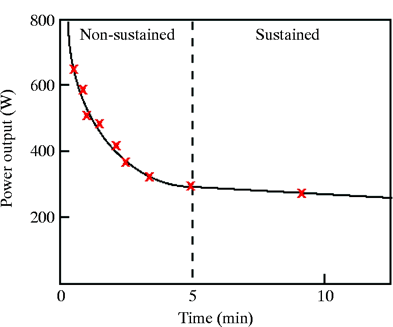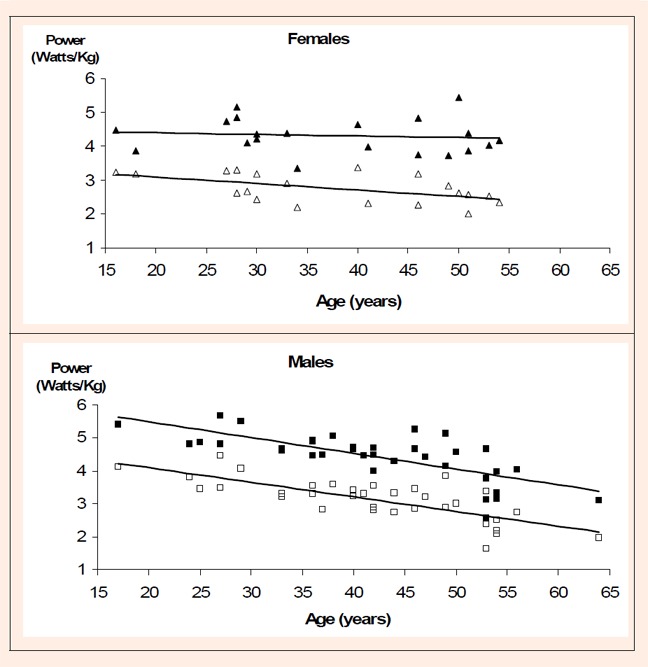How Much Electricity Can a Human Generate?
I took part in an exercise study several years ago that measured the effect of a nutritional supplement on human performance. As part of that study, the investigators measured my power output while pedalling a stationary bike. It was over 300 watts.
And yet, when I'm working at my pedal-powered computer desk, I'm only able to generate 60-70 W of electricity. Why is it so much lower?
There are multiple factors that influence how much electricity you can generate using a pedal-powered generator. Some are biological, some depend on the design of your generator. Let's look at them one-by-one.
Biological Factors
Duration
Your power output depends on how long your exert yourself. Over short time periods, your power output can be quite high--healthy young men can produce several hundred watts for up to a minute or two!
But the length of time you can exert yourself at such a high level is limited. Your body gets it energy by breaking down the glycogen stored in your muscles. When exercising hard, your body cannot consume enough oxygen to fully meet its needs. As a consequence, your body breaks down the glycogen anaerobically (i.e., without oxygen), producing lactate as a byproduct. The lactate builds up in your muscles and causes a painful burning sensation, forcing you to stop exerting yourself so hard.
During longer, less intense periods of exercise, your body uses oxygen to breakdown glycogen and fats for energy. This aerobic ("with oxygen") metabolism does not produce lactic acid, so you don't feel as fatigued. However, your aerobic power output is only about 25-35% of your anaerobic power output.
If you plot your average power output over different time periods, you'll get the following graph:

The horizontal portion of this graph is the region you'll spend most of your time pedalling and generating electricity. I call it your sustainable power output level. It's how much power you can produce regardless of how long you pedal.
Fitness Level
Your sustainable power output depends on your fitness level. Some elite athletes can maintain 350 W or more for more than 30 minutes. A fit recreational cyclist, you can probably maintain about 200 W, while the average, untrained person can produce about 100 W.
| Fitness Level | Average Power Output (> 30 min) |
|---|---|
| average, untrained person | 100 W |
| "fit" recreational cyclist | 200 W |
| elite cyclist | 350+ W |
It should be noted that your fitness level responds to training. The more you exercise, the higher your sustainable output will become. This mean your average average power output will usually grow the more time you spend pedalling and generating your own electricity.
Age and Gender
Your power output also depends on your age and gender. It increases up to about age 20, plateaus until you're about 35, gradually declines to about age 50-60, then declines more rapidly after that. This is only a general rule, however; for elite athletes, power output appears to decreases gradually age 20:

Men, in general, can produce a little more power than women, due to the fact that men on average have more muscle mass than women.
Multitasking Ability
Doing something else (like working on a computer or watching a movie) while pedaling a pedal generator reduces your power output. If you attempt to make up for this by pedaling harder or faster, your ability to concentrate on the other task suffers. You cannot do both well at once.
A 2014 study involving 10 male college students and faculty members who took a 10 minute typing test while pedaling a recumbent exercise bike found their power output was 38 +/- 14 W. This is roughly half of what would be expected otherwise.
Based on my experience and those who have used my machine, along with researchers I have consulted with, the maximum power someone can sustain while engaged in a task is about 60-70 W. Anything above that amount will cause you to be significantly less productive in the task you're doing.
FWIW, I generate 60-70 W of electricity when I'm working on my computer in the morning, and 55-60 W in the evening before bed. I am generating 66 W while I write this.
Environmental Temperature
Pedalling in a stationary position at room temperature will make you uncomfortably sweaty after a few minutes, unless you limit your power output by pedalling more slowly or take some other measures to keep cool.
Some of those measures may include:
- work in a cool room,
- wear cooler clothing (like shorts and a t-shirt), and/or
- use a fan
Usually, I need to use a fan. Assuming the fan is powered by your generator, you'll need to subtract it's power consumption from your power output. My small 12 V DC fan consumes 3 W of electricity. So, if I'm generating 65 W of electricity, my usable net power output would be 65 W - 3 W = 62 Watts.
If you work in an office environment where you can't control the room temperature, wear cooler clothing, or use a fan, your maximum power output will probably be much less--about 30-40 W--to keep from perspiring excessively.
Generator Efficiency
So far, we've assumed that all the power your body produces is converted to electricity. However, that is not true--pedal-powered generators are not 100% efficient. There are three sources of losses:
- mechanical power losses - energy lost in the drive system that transfer the crank's rotational energy to the generator
- generator losses - energy lost converting the rotation of the generator shaft into electricity
- post-conversion losses - energy converting the output from the generator into useful electricity
Mechanical Power Losses
Most people pedal at a rate of about 60-80 revolutions per minute (RPM). But to generate sufficient levels of voltage and power, most generators need to rotate much faster. This requires a sequence of gears, chains, belts, and/or drive wheels. Each step in that sequence results in a loss of power. These losses compound on one another, so the more gears, chains, or belts used, the more power is lost.
Drive systems are usually 85-98% efficient, depending on the method of power transmission and number of steps.
Generator Losses
The greatest power loss occurs in the second step, the conversion of rotational energy to electricity in the generator. Most bicycle generators can only convert about 60-80% of their power input into useful electricity. A generator's efficiency depends on both the generator's design and the speed at which it rotates. It's worth noting that a generator's operating speed is often not the speed at which it's most efficient at generating power.
Post-Conversion Losses
A final source of power loss occurs converting the generator's output into usable electricity. Every piece of electrical equipment has specific power requirements in terms of voltage, current, and type of electricity (direct-current (DC) or alternating current (AC)). The more conversion required, the greater the power loss.
Pedal-powered generators produce DC electricity, either directly (brushed generators) or after rectification (brushless generators), so the least loss occurs when devices are powered directly using DC. Most mobile phones, for instance, can be charged using a USB cable, which provides the phone with DC electricity. Under these conditions, the only conversion required is to step down the generator's voltage output (usually about 12V DC) to 5V DC using a DC-to-DC converter. These type of converters are usually very efficient (~95%).
If you want to power something through its wall plug, though, more conversion will be required. You will need a DC-to-AC inverter to convert the generator's DC output to AC electricity. This process is somewhere 60-90% efficient, depending on the inverter and total amount of power being converted.
Overall Generator Efficiency
Each of the losses described above compound on one another, reducing the overall efficiency.
In the best-case scenario, a well-designed pedal generator with a highly efficient drive train and generator, powering only DC equipment, would be about 74% efficient:
overall generator efficiency (best case) = 98% x 80% x 95% = 74%
On the other hand, a poorly-designed pedal generator, with an inefficient drive system, generator, and AC inverter will have an overall efficiency less than half of that:
overall generator efficiency (worst case) = 85% x 60% x 60% = 31%
It's worth noting that, even in the best case, about 1/4 of your power output is wasted; in the worse case, more than 2/3 is lost.
Conclusion
The amount of electricity you can generate using a pedal-powered generator depends on a number of biological factors, like your age and fitness level, as well as the efficiency of the generator you are using. An average person capable of producing a sustained power output of 100 W can expect to generate from 31 to 74 W, depending on the efficiency of the generator system. If you're trying to multitask (e.g., work on a computer while you pedal), your output will be less, between 18 W and 65 W of electricity.
That may not sound like much, but it can be enough to power an energy-efficient office like mine.